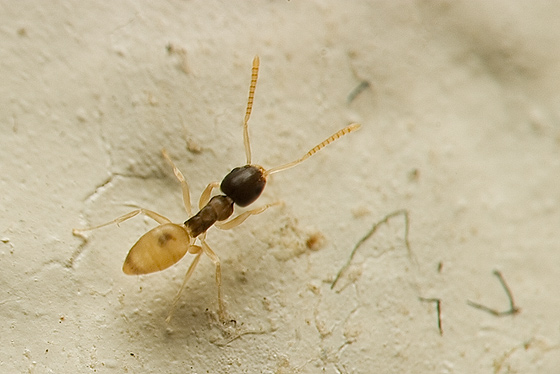Interactions
The ghost ants main form of interacting with
other organisms comes from predator/prey
relationships. T. melanocephalum has been recorded as preying on
"diamondback moth larvae in India," "destroying eggs and larvae
of houseflies in Puerto Rico," "two-spotted spider mites and
aphids in glasshouses in Florida," "flea
eggs and larvae," "the vector of Chagas' disease in coastal
Venezuela," and many other small insects (Harris, 2005).
Another way ghost ants prey on other organisms but do not
necessarily eat them is when they
tend to sap producing plants. The ghost ant will consume honeydew excreted
by insects such as mealy bugs of
sugarcane, scale insects, and aphids that extract the
sugar-rich fluid from plants (Wetterer, 2009;
Harris, 2005). In areas where both organisms are prevalent, the
ghost ant also tends to the fruit scales on the
banana plant and a myrmecophilous butterfly of the genus
Zizeeria (belongs to the same family as the
Papilio glaucus butterfly) (Harris, 2005).
In some instances Tapinoma
melanocephalum aids in pollination as well, which can be
observed with Jatropha curcas specifically (Luo et al, 2012).

For the reverse relationship of ghost ants being prey, "[N]o information was found on predators,
parasites or parasitoids that attack T. melanocephalum."
but with the increasing distribution this should soon be an
aspect of interest (Harris, 2005).
When it comes to interacting with other ants that are present in the same habitat as T.
melanocephalum, the ghost ants are usually out competed.
This is
because ghost ants can easily accommodate various food sources
and habitats so they
can easily move to different habitats and it is not a huge
disturbance. The
ghost ants are also usually out numbered because they have
smaller nests which causes foragers to have a hard time
acquiring food. The end result is
that the ghost ants leave the habitat almost immediately and
there is no major interaction with the other species (Espadaler
et al, 2002; Harris,2005).
Although, it has been documented that in Costa Rica a "slaticid
spider (Continusa sp.) that resembles the ant builds
silken retreats at the periphery of nests, seems to emigrate
with the host, and is probably a symbiont (Shepard & Gibson
1972). The spiders provide the ants with protection from
predators and parasites, while the ant nest is used as a
foundation for web construction." (Harris, 2005).
To find out more interesting aspects of this
organism, check out the facts page.